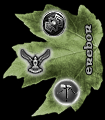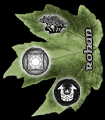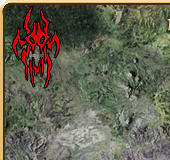|
'And out of the East Men were moving endlessly: swordsmen, spearmen, bowmen upon horses, chariots of chieftains and laden wains.' - The Fellowship of the Ring A general term for all regions east of Wilderland, Rhûn is a land of mystery and legend. This land is home to a hardy and warlike race of Men known collectively as Easterlings. Grown from the nomadic tribes of ancient times, these swarthy people have developed their own culture away from the elvish influence of the West, and are practiced in many arts and sciences. A brutal people, tempered by the harsh lands in which they live, they have known an eternity of strife since their earliest times. The lands of the East have seen many migrations in their long history. All the Children of Ilúvatar could trace their ancestries back to the eastward regions of Middle-earth from the lands of Cuiviénen and Hildórien where both Elves and Men first awoke, and still peopled by lost Elves, Avari and Úmanyar who forsook the great westward march, and four of the great houses of the Dwarves once built their cities under the mountains of the East which include the range of red mountains known as the Orocarni. The mighty inland Sea of Rhûn, densely forested to the north and ringed by hills to the south, separates the lands of Rhovanion and Rhûn, and is the closest part of this realm to the lands of the West. The Men of the East have since formed many great tribes, kingdoms, and realms in the vast deserts, plains and hills, along the steppes and tundra to the north or in the mountains, forests, and swamps, and traveller’s tales speak of magnificent cities and temples which were dedicated to the worship of the Dark Lord Morgoth. Those of the Elves and Dwarves who dwell within Rhûn learned long ago to hide from the Easterlings, or became allies with the gentler eastern peoples, or were corrupted themselves. Three of the Five Wizards are said to have passed into the East, but whereas one returned (who was none other than Saruman) word of the other two came never again to the West. It may be that they stirred up resistance to Sauron's dominion, forcing the Dark Lord to divert considerable forces to maintaining control over those areas, forces that would have otherwise have been used to overwhelm the West during the War of the Ring. Or they may have been the founders of secret cults that would have survived into later ages. But it is also rumored that, like Saruman, those wizards fell into corruption and darkness. Perhaps they served Sauron as lieutenants, and they may have taken to themselves such power as to one day become Dark Lords themselves. The Easterlings The sallow-skinned men of the East are tall and strong limbed, with dark hair and fierce eyes. A cruel and brutal people, they show no mercy to their foes and expect none in return. Sauron looked upon them as his elite soldiers during the War of the Ring, and were well used against the Men of Gondor. The histories of the Elves record the first coming of the Swarthy Men of the East during the time of the sons of Fëanor in the First Age of Middle-earth. Ulfang the Black led his people to Beleriand in the year 463, and dwelt for a time in the lands to the north and south of the March of Maedhros, along with the people of Bór. Ulwarth and Ulfast, Ulfang’s sons, joined their father in his original pledge of allegiance to Caranthir, the foulest of the sons of Fëanor. However, the weak minds of men were lured by the dark power of Morgoth, and secretly turned to his employ. During the Nirnaeth Arnoediad, the Battle of Unnumbered Tears, the Noldor relied on the Men of Ulfang and Bór to march with them and confront the orcs of Morgoth. However, the Easterlings handed the Dark Lord victory when they suddenly betrayed the allied forces of Good, whom they had once served, and turned upon them in battle. However, the people of Bór remained faithful to the Sons of Fëanor and even succeeded in slaying the Sons of Ulfang, but were ultimately slain by the forces of Morgoth. Following the Fifth Battle of Beleriand, the Easterlings were themselves betrayed by their Lord Morgoth, and were locked in the land of Hithlum, near the icy waste of Helcaraxë in the north of Beleriand. After the War of Wrath, when the Eldar, the Edain and the Valar finally threw Morgoth down, the people of Ulfang who had survived the glory of the Host of the West fled Hithlum and the Easterlings travelled over the Blue Mountains and back into Middle Earth. Whereas many of them came into the wild and lawless regions of Eriador and beyond, and there they had kinsmen, and those who had served Morgoth and were loyal to him, cast upon them a shadow of fear, and were taken for kings. In the Second Age, when Sauron was revealed to be the new Dark Lord, the Men of Rhûn willfully joined his cause, and even fought in the War of the Last Alliance on the side of Darkness, but that too proved ill for them. Sauron was defeated by the Alliance and his Ring was lost, and with his army scattered and broken, the Easterlings once again fled back into the East. Stirred up by Sauron, the Easterlings have attacked Gondor many times, often coming near to overthrowing it. A confederation of Easterling tribes descended upon Gondor shortly after the Great Plague of TA 1636, and for nearly a hundred years the chariotborne warriors remained a constant threat. They quickly overran Rhovanion, descimmating much of its inhabitants and were able to coordinate attacks on Gondor from the north and east. In the Battle of the Plains, the King Narmacil II of Gondor was slain by the Wainriders, and the Easterlings claimed all of the South Kingdom’s possessions east of the Anduin. Narmacil’s son Calimehtar, aided by Marhwini and a revolt by the enslaved Men of Rhovanion, later won a temporary reprieve when he beat back the Wainriders on the Plain of Dagorlad, and bought Gondor and Rhovanion some time to recover. However, with the brutal nature of the Easterlings, revenge was swift, and a great alliance between Rhûn, Khand and Near Harad brought about simultaneous assaults on Gondor from the north, east and south. The Wainriders and Variags pursued the Gondorians to the Black Gate, whilst the Haradrim trampled through southern Ithilien. The kingdom of Gondor was brought perilously close to destruction as King Ondoher and both his heirs were viciously cut down. However, Eärnil, the Captain of the Southern Army of Gondor, was victorious in defeating the Haradrim, before marching north through Ithilien to attack the Wainriders by surprise. The Easterlings were driven back to the swampland of the Dead Marshes where they were finally defeated and retreated to Rhûn. Years later a new threat would come from the east in TA 2509, a race of Men that the Gondorians called the 'Balcoth' or 'Horrible Horde' in both Westron and Sindarin. The Balchoth were a fierce race of Easterlings, similar to the Variags of Khand, but descended from the Wainriders, which could be seen with their similar use of horses and wains. They were only rudely armed and lightly armoured, but what they lacked in quality of arms they made up with sheer numbers, they also possessed crude rafts and small boats which they would use to cross the Anduin. It is rumoured that these people fell under the rule of Dol Guldur during its occupation by the Dark Lord Sauron. Under orders from the Great Eye they unleashed their fury upon the plains of Rhovanion and Calenardhon, where they destroyed much of the surviving Northmen population that still dwelt south and east of Mirkwood and fought the forces of the Steward Cirion of Gondor. It is thought that they would have won, for the army of Gondor were trapped between the Balcoth and orcs that had descended from the Mountains, were it not for the unlooked for arrival of the Éothéod of the North. Led by Eorl the Young, the army of horsemen from the North slew the Balchoth and orcs, and forced the surviving remnants of Easterlings back into the East. In return for this great favour, Cirion granted Eorl with the land of Calenardhon to dwell in, and it was renamed Rohan. The Éothéod became known as the Rohirrim, or Horse Lords, and Gondor and Rohan had perpetual friendship as long as each realm lasted. From then on the descendants of the Balcoth became bitter enemies with the Rohirrim, and often times battle would be joined upon the Wold of Rohan, where Eorl the Young and his steed Felaróf met their end. The Easterlings played a key part in the War of the Ring, holding true to their sworn allegiance to Morgoth centuries before, and serving Sauron until his downfall. With their aid, Sauron diverted the attention of the Gondorian army and retook Mordor unopposed. He found use for the Easterlings once more during the great war: from Rhûn came many foot soldiers, heavily armoured and well armed; an even match for the men of Minas Tirith, and new hosts of horsemen who appeared to have been of both Variags and Easterlings descent. Khamul the Shadow of the East, second in command of the Ringwraiths, who was once a great king of the Easterlings himself, commanded much of the armies of Rhûn, as well as Dol Guldur during the War of the Ring. Their discipline and tenacity made them excellent first-wave troops to unseat the Gondorians before countless waves of orcs and trolls rolled over the defenders. In both the South and North, at the Siege of Minas Tirith and the Battle of the Morannon and at the Battle of Dale and the Siege of Erebor, the Easterling warriors proved their prowess, but ultimately all the followers of Sauron shared in his downfall. After the Dark Lord's destruction, they either surrendered or fled back east. In the Fourth Age, King Elessar makes piece with some, but not all Easterling realms, but those Easterlings who most willingly participated in Sauron's empire resist Elessar for several decades, forcing King Elessar and Eomer to fight many wars in Rhûn to pacify the remaining enemies of Gondor as best as they might. In warfare, Easterling tactics, weapons and armour differ significantly from those of the faithful Houses of Men, from their use of both long and short poleaxes and scimitars, to their bows and arrows, to their armour design and function. Over the centuries, from their settlement in the east up until the Third Age, the people of Rhûn developed a technique of fast, disciplined raids using their chariots and wagons (or “wains” - giving them the name the Wainriders). Used by the elite soldiery of Rhûn, they have developed a strategy of rapid flanking movements to catch their opponents off guard. Perfect for combat in open terrain, these vehicles are commonly seen on the plains of Rhûn and Khand. The bane of infantry and cavalry alike, Chariots are used in battle to skirt the flanks of the enemy and crush their forces from the sides, with their heavywheels and wicked scythes. A skilled charioteer could also fight from the back of his vehicle, using the power that its speed bestows to his advantage. Alternatively, chariots are used as steeds for heroes and champions to quickly move about the battlefield giving their commands to the troops before leading the charge. Chariots are rarely seen in the Western realms of Middle Earth, but the thunder of hooves and the rumble of wheels are fast approaching from the East. |















